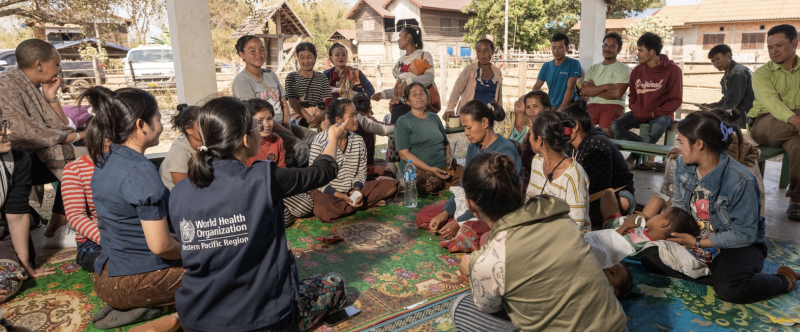
Supporting communities to improve preparedness and response to epidemics and pandemics
Communities, through daily decisions and actions, influence the trajectory of an epidemic – whether prevention measures, community-based surveillance, testing or vaccine uptake. Community protection, a concept which places communities at the centre of pandemic preparedness and response, aims to strengthen community preparedness and resilience to, and readiness for health emergencies. It is supported by the Pandemic Influenza Preparedness Framework Partnership Contribution (PIP PC) under the High Level Implementation Plan III (2024-2030). Within PIP, it includes risk communication and community engagement, knowledge translation, infodemic management and multisectoral engagement to strengthen community level health systems.
In 2024, this pillar addressed the challenges arising from the avian influenza outbreaks across the world, through convening global communities of practice, translating science in a timely, accessible and relevant way for evidence-informed decisions, and strengthening risk communication and community engagement (RCCE) and infodemic management capacities. The global, regional and country actions complemented each other to strengthen country capacities.
Understanding the community protection approach
With greater global understanding on the critical role Community Protection plays in pandemic influenza preparedness, there has been a surge of interest on how to adopt this approach in countries. The WHO Eastern Mediterranean Regional Office, supported by WHO headquarters, held the first global Community Protection workshop to raise awareness of what this concept means in practice.
Engaging communities
WHO’s HIVE platform, is a safe digital space that brings together members of communities to share knowledge, co-create, collaborate and crowdsource to find solutions for health emergency preparedness and response. In 2024, WHO launched the SARINet and PRET communities of practice, providing a global collaboration forum for professionals from different national and global institutions involved in influenza and respiratory pathogen preparedness.
In addition to HIVE, communities were also engaged through Civil Society Organizations (CSOs). For the first time, CSOs from all three levels (global, regional and national) were brought together for a briefing and discussion on the avian influenza H5 situation. After a WHO briefing, CSOs expressed their perspectives. Global networks, such as the Faith Network, also held get togethers.
Knowledge translation for evidence-informed actions
WHO used the WHO Information Network for Epidemics (EPI-WIN) platform to share the latest science on avian influenza to encourage evidence-informed actions. EPI-WIN, a public platform, has grown by 75% in the past 18 months, with currently over 51 000 subscribers, and reaches over 150 countries, including national and sub-national decision makers, health workers, clinicians, researchers, media, CSOs, and partners and donors. More information here. Participants used the information for capacity building in their countries, clinical practice, awareness creation and inputs for their influenza plans.
Strengthening infodemic management
WHO’s global training packages on infodemic management, social listening and risk communications and community engagement were adapted by WHO regional offices to build a cadre of trained professionals who could strengthen national and regional capacities to combat mis- and dis-information for pandemic influenza preparedness and health emergency management. Workshops held in the Caribbean, Bhutan and Fiji included 35 countries. More information on these trainings can be found here.
Capacity building: regional and country approaches to community protection
Across the Americas, Africa and Western Pacific Regional Offices, efforts have focused on building RCCE capacities and public communication materials. For example, WPRO conducted a workshop on social and behavioural insights to improve risk communications for future emergencies, and this was complemented by products specifically for avian influenza including risk communication packages, message testing and strategic guidelines.
At the country level, Cambodia’s avian influenza behaviour change campaign, and Viet Nam’s and Lao People’s Democratic Republic’s message testing efforts demonstrated the effective implementation of community engagement strategies. Similarly, Colombia took an integrative approach by incorporating community protection for vaccine deployment preparedness and burden of disease estimation – promoting evidence-based actions for audiences at national, sub-national and community levels. Ghana also conducted an influenza simulation exercise and community health worker training package to address key gaps in community preparedness in health emergencies.
With support from the PIP PC, countries have been enabled to strengthen capacities for community protection, ensuring that communities are central to pandemic influenza preparedness and response. At the national, regional and global levels, these initiatives have empowered communities to effectively manage health emergencies and mitigate the impact of a future influenza pandemic, and WHO will continue to provide support.